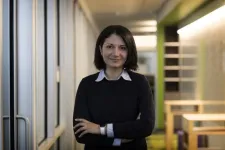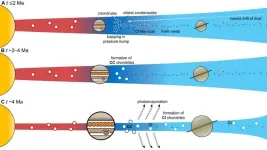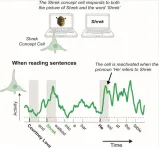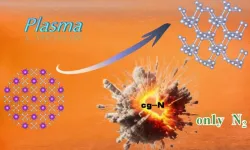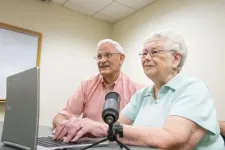(Press-News.org) Researchers from three of Virginia’s premier universities, including the University of Virginia’s Homa Alemzadeh, aim to take the risk out of self-driving vehicles by overcoming inevitable computer failures with good engineering.
The trio will share a $926,737 National Science Foundation award to identify when and where autonomous vehicle systems are most vulnerable to safety-critical failures. They plan to use this knowledge to design ways to efficiently mitigate potential safety hazards and enhance the overall system resilience.
Alemzadeh, an associate professor of electrical and computer engineering in UVA’s School of Engineering and Applied Science, is collaborating with William & Mary professor of computer science Evgenia Smirni, and George Mason University assistant professor of computer science Lishan Yang, the lead investigator.
Alemzadeh said recent studies show a significant portion of “disengagements,” in which the autonomous system is turned off by the system or a human driver for safety reasons, happen when the machine learning-based AI makes wrong decisions, or doesn’t make them in time.
“We are particularly interested in studying disengagements and safety incidents due to transient hardware faults, temporary loss of network connection or software errors,” she said.
Hunting Elusive Vulnerabilities
These often self-correcting events may cause only a momentary disruption, and then they’re gone, making them hard to find and diagnose.
For safety and reliability, self-driving vehicles depend as much on the software “controller” that makes and executes decisions for autonomous operation and machine learning components as physical parts such as sensors and brakes.
If transient faults are activated at a critical operational time, they can propagate throughout the system’s hardware and software layers, evade existing safety checks and create hazards.
“We aim to look at the end-to-end system — from input to output — to investigate the critical fault locations within the hardware and software, as well as the system contexts that lead to activation of faults and safety hazards,” Alemzadeh said.
The researchers will focus on improving controller and machine learning components to prevent accidents. Using cross-layer reliability analysis, they plan to strategically target the most critical faults in the vast, complex software code and hardware that underlie the controller and machine-learning models.
Test-Driving Solutions in Real Time
Based on when and where they find vulnerabilities, the team will design protection mechanisms —such as automatically correcting transient faults or mitigating unsafe vehicle operations by automatically slowing down — that can be applied selectively at different times and locations to ensure safety while maximizing efficiency.
The team will validate their solutions through closed-loop testing in which the autonomous system and its safety features will be tested in real time using driving simulations under varying weather, road and traffic conditions. They will concurrently simulate faults and errors to assess those impacts and the performance of their solutions.
The three-year NSF project, End-to-End Resilience in Autonomous Driving Systems: Strategic Vulnerability Assessment and Mitigation, follows a previous collaboration between Alemzadeh and her colleagues. Toward Trustworthiness in Autonomous Vehicles, funded by the Commonwealth Cyber Initiative Coastal Virginia regional node, laid the groundwork for the current project.
With four regional nodes, the Commonwealth Cyber Initiative is a coalition of state higher education institutions that partners with government, industry and non-government organizations to make Virginia a global leader in cybersecurity through research, innovation and workforce development.
Alemzadeh also is a member of UVA Engineering’s Link Lab, a multidisciplinary research and education center for cyber-physical systems, and holds a courtesy appointment in computer science.
END
Autonomous vehicles can be imperfect — As long as they’re resilient
2024-09-27
ELSE PRESS RELEASES FROM THIS DATE:
Asteroid Ceres is a former ocean world that slowly formed into a giant, murky icy orb
2024-09-27
Since the first sighting of the first-discovered and largest asteroid in our solar system was made in 1801 by Giuseppe Piazzi, astronomers and planetary scientists have pondered the make-up of this asteroid/dwarf planet. Its heavily battered and dimpled surface is covered in impact craters. Scientists have long argued that visible craters on the surface meant that Ceres could not be very icy.
Researchers at Purdue University and the NASA's Jet Propulsion Lab (JPL) now believe Ceres is a very icy ...
McMaster researchers discover what hinders DNA repair in patients with Huntington’s Disease
2024-09-27
Researchers with McMaster University have discovered that the protein mutated in patients with Huntington’s Disease doesn't repair DNA as intended, impacting the ability of brain cells to heal themselves.
The research, published in PNAS on Sept. 27, 2024, found that the huntingtin protein helps create special molecules that are important for fixing DNA damage. These molecules, known as Poly [ADP-ribose] (PAR), gather around damaged DNA and, like a net, pull in all the factors needed for the repair process.
In people with Huntington’s Disease, however, the research found that the mutated version of this protein doesn’t function properly ...
Estrogens play a hidden role in cancers, inhibiting a key immune cell
2024-09-27
DURHAM, N.C. – Estrogens are known to drive tumor growth in breast cancer cells that carry its receptors, but a new study by Duke Cancer Institute researchers unexpectedly finds that estrogens play a role in fueling the growth of breast cancers without the receptors, as well as numerous other cancers.
Appearing Sept. 27 in the journal Science Advances, the researchers describe how estrogens not only decrease the ability of the immune system to attack tumors, but also reduce the effectiveness of immunotherapies that are used to treat many cancers, notably triple-negative breast cancers. Triple-negative ...
A new birthplace for asteroid Ryugu
2024-09-27
In December 2020 the space probe Hayabusa 2 brought samples of asteroid Ryugu back to Earth. Since then, the few grams of material have been through quite a lot. After initial examinations in Japan, some of the tiny, jet-black grains traveled to research facilities around the world. There they were measured, weighed, chemically analyzed and exposed to infrared, X-ray and synchroton radiation, among other things. At the MPS, researchers examine the ratios of certain metal isotopes in the samples, as in the current study. Scientists refer to isotopes as variants of the same element that differ only in the number of neutrons in the nucleus. Investigations ...
How are pronouns processed in the memory-region of our brain?
2024-09-27
A new study shows how individual brain cells in the hippocampus respond to pronouns. “This may help us unravel how we remember what we read.”
Read the following sentence: “Donald Trump and Kamala Harris walked into the bar, she sat down at a table.” We all immediately know that it was Kamala who sat at the table, not Donald. Pronouns like “she” help us to understand language, but pronouns can have multiple meanings. Depending on the context, we understand who the pronoun is referring to. But ...
Researchers synthesize high-energy-density cubic gauche nitrogen at atmospheric pressure
2024-09-27
Recently, a research group led by Prof. WANG Xianlong from the Hefei Institutes of Physical Science of the Chinese Academy of Sciences, successfully synthesized high-energy-density materials cubic gauche nitrogen (cg-N) at atmospheric pressure by treating potassium azide (KN3) using the plasma-enhanced chemical vapour deposition technique (PECVD).
The research results were published in Science Advances.
Cg-N is a pure nitrogen material consisting of nitrogen atoms bonded by N-N single bonds, resembling the structure of diamond. It has attracted attention because it has a high-energy-density and produces only nitrogen gas when it decomposes. ...
Ancient sunken seafloor reveals earth’s deep secrets
2024-09-27
University of Maryland scientists uncovered evidence of an ancient seafloor that sank deep into Earth during the age of dinosaurs, challenging existing theories about Earth’s interior structure. Located in the East Pacific Rise (a tectonic plate boundary on the floor of the southeastern Pacific Ocean), this previously unstudied patch of seafloor sheds new light on the inner workings of our planet and how its surface has changed over millions of years. The team’s findings were published in the journal Science Advances on September 27, 2024.
Led by geology postdoctoral researcher Jingchuan Wang, the team used innovative seismic imaging techniques to ...
Automatic speech recognition learned to understand people with Parkinson’s disease — by listening to them
2024-09-27
As Mark Hasegawa-Johnson combed through data from his latest project, he was pleasantly surprised to uncover a recipe for Eggs Florentine. Sifting through hundreds of hours of recorded speech will unearth a treasure or two, he said.
Hasegawa-Johnson leads the Speech Accessibility Project, an initiative at the University of Illinois Urbana-Champaign to make voice recognition devices more useful for people with speech disabilities.
In the project’s first published study, researchers asked an automatic ...
Addressing global water security challenges: New study reveals investment opportunities and readiness levels
2024-09-27
NEW YORK, September 27, 2024 – Water scarcity, pollution, and the burden of waterborne diseases are urgent issues threatening global health and security. A recently published study in the journal Global Environmental Change highlights the pressing need for innovative economic strategies to bolster water security investments, focusing on the “enabling environment” that influences regional readiness for new business solutions.
Initiated and led by researchers at the Advanced Science Research Center at the CUNY Graduate Center (CUNY ASRC), ...
Commonly used drug could transform treatment of rare muscle disorder
2024-09-27
The study, published in Lancet Neurology, detailed the “head-to-head” trial implemented by the researchers to test two drugs, mexiletine and lamotrigine, on people with the condition.
The trial, which was conducted at the UCL Queen Square Multidisciplinary Centre for Neuromuscular Diseases and the National Hospital for Neurology and Neurosurgery, UCLH, involved 60 adults with confirmed non-dystrophic myotonia.
Patients were randomly assigned to receive either mexiletine for eight weeks followed by lamotrigine for eight weeks, or the reverse order, with a seven-day ...
